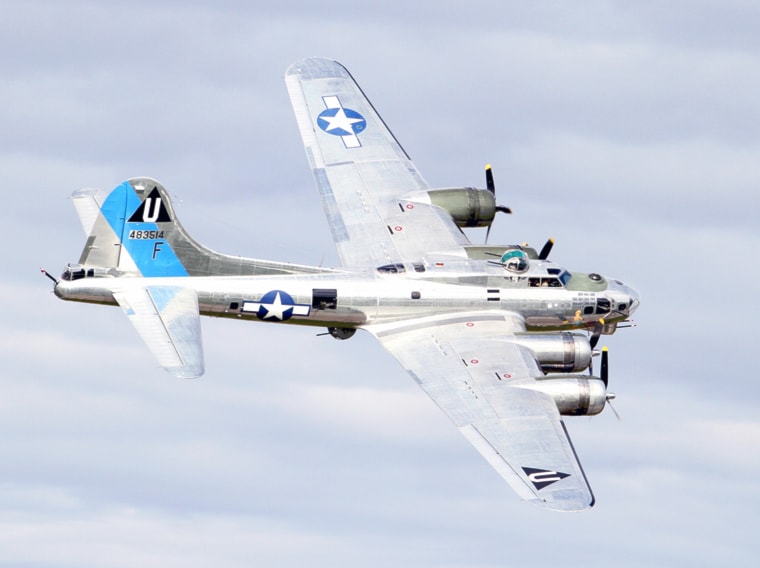The four 1,200-horsepower Wright Cyclone engines announced it was go-time with an ear-splitting roar.
Only a few metres below my feet, the runway slid underneath the plexiglass nose of the Second World War-era B-17 Flying Fortress, one of only about a dozen still flying around the world.
From my perch, the end of the runway seemed to loom ahead alarmingly close with no obvious sign of any flying happening.
Then, my pulse quickening by the second, we were suddenly airborne, golden fields racing blurringly by below.
Welcome to flying — old school.
Over the next half hour, six aviation enthusiasts, who paid $1,000 each, and a pair of media representatives got an unforgettable taste of the kind of flying experienced by tens of thousands of young men who answered war’s call 70 years ago.
Inside the B-17’s cramped interior, 10 men, many of them only teenagers, took the fight to the skies over Germany.
“A lot of these fellas never made it back in these things,” said load master Bob Brademeyer in his pre-flight briefing at the Red Deer Flying Club’s building at Red Deer Airport.
He makes a point of paying tribute to those who risked their lives during the war when he talks to people about the history of the plane named Sentimental Journey.
The average age of pilots was only 20 or so.
The gunners who manned the Flying Fortress’s 13 50-calibre guns were usually even younger, he said.
Of the 12,700 B-17s built, nearly a third were lost in combat in the skies over Europe or the Pacific and thousands of aircrew died.
Flying through flak-filled skies must have been a frightening and exhausting experience.
Even in Red Deer’s friendly skies, the deafening drone of the engines and the constant vibration that shakes every surface soon wears on you.
Moving about inside means half-crawling through narrow passages along a metal catwalk only a few centimetres wide. Passengers are warned to stick to the catwalks and wooden flooring and not to tread on the plane’s fuselage. It’s only aluminum held together with a few rivets, we’re told.
And stay out of the bomb bay. It only takes 45 kg (100 pounds) of weight to pop the doors open.
Passenger Gary Sorensen marvelled at the thin aluminum skin that was all that stood between the bomber’s crew and the cannon and machine-gun rounds of German fighter planes.
“You can see how people got picked apart so easily by those machine-guns. These walls are very thin.”
For Sorensen, the flight was a surprise from his fiancée and he came away thrilled.
“It was pretty incredible,” he said. “It’s something you can’t compare until you get on it.
“I think it was a great experience — a lifetime experience,” said aviation enthusiast Lawrence Heck. “It was really something to see. It was exciting.”
One of two pilots on board, Reid MacCosham of Arizona, said flying the B-17 is a big departure from the high-tech airliners he guides through the skies in his day job.
The B-17 is all cables and pulleys and other basic mechanical controls. Wires slide back and forth along the fuselage as the pilot adjusts control surfaces.
MacCosham said there’s not much left on the plane that is original. The engines have been replaced many times over and every 25 hours each engine undergoes detailed maintenance. That maintenance schedule means all four engines have been fully inspected, oiled and fine tuned after 100 hours of flying time. Then, the process starts all over again.
Sentimental Journey rolled off a California production line in late 1944. It arrived too late to join the thousands of other B-17s that formed the backbone of the United States Air Forces campaign against Nazi Germany.
It was sent to the Pacific theatre in early 1945 for the duration of the war and later went on to a diverse career as a photo-mapping plane, air-sea rescue craft, a drone control plane during nuclear tests and a firefighting water bomber.
Arizona’s Commemorative Air Force bought it in 1978 and fully restored it to flying condition.
On its latest tour, the plane has already made stops in Cranbrook, B.C., Medicine Hat, Calgary and Edmonton.
The warbird is here as a fundraiser for the Harvard Historical Aviation Society, which is developing a museum at the Red Deer Airport to celebrate the area’s aviation heritage.
It will be at the Red Deer Airport all day today and will be open to the public from 10 a.m. to 9 p.m. Those who want to come out and take a look inside are asked to make a $5 donation.
Jodi Smith, president of the aviation society, said they are hoping to raise $10,000 during the B-17s stay. The money will go towards the development of a series of hands-on displays that the society hopes to take around Central Alberta, and which will eventually form the heart of the museum’s collection.
The plane will leave the Red Deer Airport between 8 a.m. and 9 a.m. Thursday as it heads for another tour stop in Montana.
pcowley@www.reddeeradvocate.com
